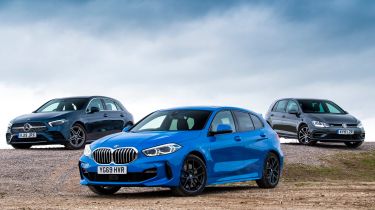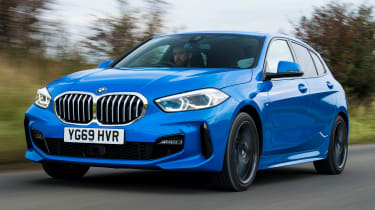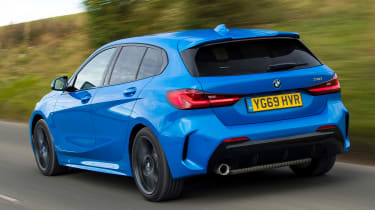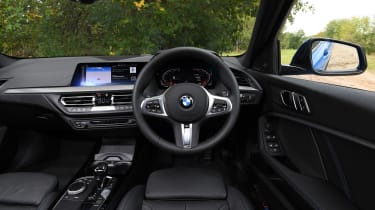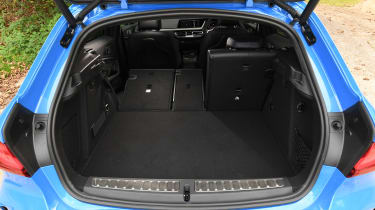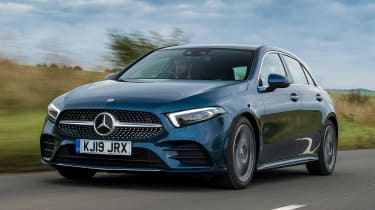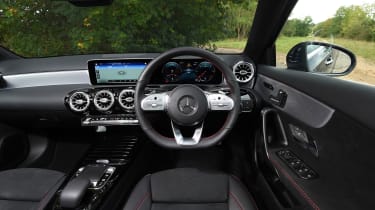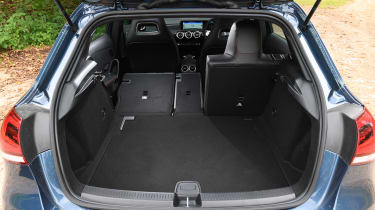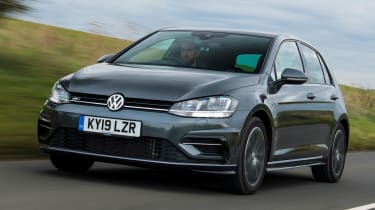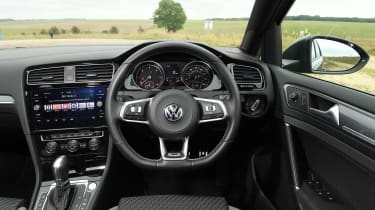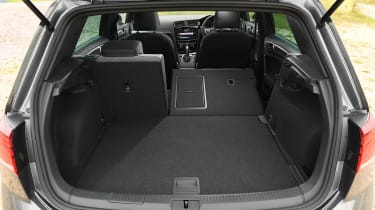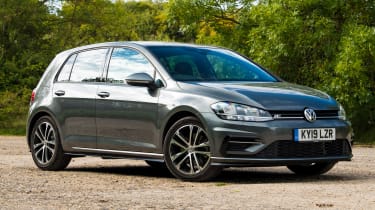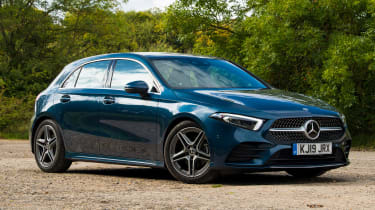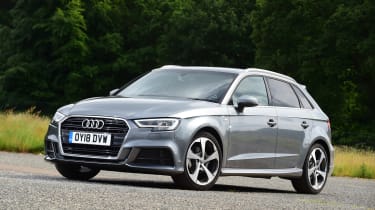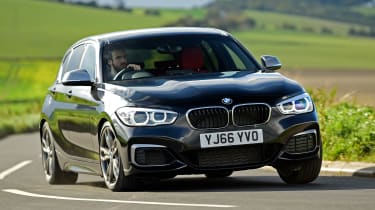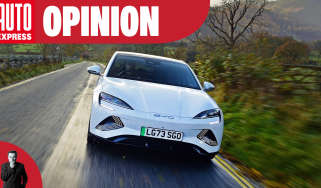BMW 1 Series vs Mercedes A-Class vs Volkswagen Golf
We pitch the new BMW 1 Series against the Mercedes A-Class and Volkswagen Golf
The BMW 1 Series has been around since 2004, and until this latest model arrived, it offered something no other car in the class had: rear-wheel drive. While that has benefits for handling and performance, there are plenty of reasons why every other rival drives the front wheels; it’s more cost-effective to build and allows for better packaging. And now BMW’s latest small hatch has switched to join its competition with a more conventional layout.
The 1 Series is completely new as a result, and that means we’re taking a close look at every key area: practicality, technology, running costs and more, all of which will be crucial if the newcomer wants to become class champion.
Premium hatches need to offer a high-quality interior and a grown-up driving experience, and two key rivals for the 1 Series, the Mercedes A-Class and the Volkswagen Golf, offer exactly that. The former came along last year, bringing with it technology that had never been seen in this class before, while the latter has been at the pinnacle of the hatchback class for many years. Can the revamped BMW fend off the challenge from these tough rivals?
BMW 1 Series
| Model: | BMW 118i auto M Sport |
| Price: | £28,580 |
| Engine: | 1.5-litre 3cyl petrol, 138bhp |
| 0-60mph: | 8.7 seconds |
| Test economy: | 39.9mpg/8.8mpl |
| CO2: | 114g/km |
| Annual road tax: | £145 |
The all-new BMW 1 Series has a lot to prove. Can it be as fun to drive as its rear-wheel-drive predecessor, while still matching the comfort and tech of its rivals here? We’re looking at the 118i M Sport, which costs £28,580 in auto form.
Used - available now

2024 BMW
1 Series
47,451 milesAutomaticPetrol1.5L
Cash £18,421
2021 BMW
1 Series
37,877 milesManualDiesel2.0L
Cash £17,680
2020 BMW
1 Series
28,430 milesAutomaticPetrol1.5L
Cash £18,733
2024 BMW
1 Series
13,369 milesAutomaticPetrol1.5L
Cash £21,286Design & engineering
The 1 Series now sits on BMW’s UKL2 platform. This means it’s the first 1 Series not offered in rear-wheel-drive form, and while the M135i performance variant is now four-wheel drive, most models are front-drive only.
The switch to this platform and powertrain layout is unusual, because BMW is known for its driver-focused models with rear-wheel drive. However, this change creates much more interior space within the same footprint, and with no transmission tunnel for the propshaft, there’s more foot space in the back.
Manual and automatic gearboxes are available, and we’re testing the seven-speed auto here. The 1 Series is also fitted with a new stability control system, which means the tech is more closely integrated with the powertrain, improving its responsiveness.
Our M Sport model is fitted with 10mm lower suspension that’s specific to this trim, and the £1,800 M Sport Plus Pack also adds uprated brakes with larger calipers that mean 18-inch wheels are fitted. There’s a different steering set-up, too.
The 1 Series’ interior has been totally overhauled thanks to the new architecture, and the design is similar to that of the larger 3 Series – much like the A-Class’s interior feels similar to the one in the C-Class. Build quality in the BMW is very good, with enough high-quality materials and interesting finishes to make it feel like an upmarket premium hatch.
It doesn’t look quite as hi-tech as the Mercedes’ class-leading interior, but with the BMW Live Cockpit Professional set-up added as part of the Tech Pack (£1,500), our car’s dual infotainment and instrument display screens mean it has as much tech. Standard kit includes heated leather seats, cruise control, LED headlights, sat-nav, Apple CarPlay and keyless go.
Driving
Keen drivers need not worry that the BMW 1 Series has switched to front-wheel drive, because it’s brilliant to drive, even in basic 118i form.
It’s the most agile car here by some margin, with loads of grip and a very lively chassis. This is enhanced by the clever ESC system, which helps turn the car sharply into the bend with a lift of the throttle. It’s more sophisticated than its rivals’ in this sense, because the computer systems enhance rather than end the fun while cornering. It’s a shame that the steering is too heavy in Sport mode, but you can set the steering weight to remain in Comfort even with the powertrain in Sport.
The 118i model features a three-cylinder petrol engine producing 138bhp and 220Nm of torque, which makes it the least powerful model here. Still, the engine is very quiet, and the superb handling means that even with a performance deficit, the 1 Series is by far the most engaging car here.
On a wet test track the 118i took 8.7 seconds to go from 0-60mph and 8.3 seconds between 30-70mph through the gears. The A-Class took 7.4 seconds and 6.8 seconds in those tests, while the Golf took 7.8 and 6.8 seconds respectively. This clearly demonstrates how the BMW performs on the road; it’s a little slower than its rivals, but a difference of less than a second when compared to the Golf isn’t such a wide margin that it takes away from the BMW’s enjoyment.
The dual-clutch gearbox is another highlight, because it’s much more responsive and smoother than the equivalents in the Mercedes and VW. The only time that you’ll notice a jerky shift is when accelerating at full throttle, while the rest of the time it’s very well behaved.
Even on its lowered M Sport suspension, the 1 Series rides very well. It’s not immune to small bumps on rough roads, suffering from a bit of vibration, but that’s true in both rivals, and the BMW deals with big bumps and potholes better because they don’t crash or thump into the cabin.
Practicality
The 1 Series’ new platform means there’s more interior space than ever before, and the BMW is now very competitive with its rivals. In fact, all three of these cars are now so close when it comes to boot capacity that it’s tough to choose between them.
The BMW has 380 litres of space, which is the same as the Golf and only 10 litres more than the A-Class. There’s a larger hatch for the 1 Series, too, so access is just as good. However, rear visibility isn’t quite as good as in the Golf.
Rear-seat space is similar as well, and while taller adults will find legroom is merely adequate, kids won’t have any trouble fitting in the back.
Ownership
EURO NCAP has just tested the 1 Series, and with AEB, lane keep assist and six airbags as standard, it managed to match its rivals’ five-star ratings. Blind-spot assist is part of the £1,000 Driving Assistant pack, though.
BMW finished 25th in our 2019 Driver Power survey, which was ahead of Mercedes in 26th, but behind VW in 17th. None of these manufacturers will be happy to finish so low in the rankings, though.
Running costs
On test the A-Class was the most efficient, returning 41.2mpg. That means you’ll spend £1,693 per year on fuel. The 1 Series managed 39.9mpg – £1,749 a year – while the Golf returned 38.6mpg, costing £1,808 a year.
Testers’ notes
“A 42-litre fuel tank is fitted as standard on the 1 Series, but that’s the smallest here. BMW does offer a 50-litre tank, which is available as an option for a reasonable £50.”
Mercedes A-Class
| Model: | Mercedes A 200 DCT AMG Line |
| Price: | £29,305 |
| Engine: | 1.3-litre 4cyl petrol, 161bhp |
| 0-60mph: | 7.4 seconds |
| Test economy: | 41.2mpg/9.1mpl |
| CO2: | 124g/km |
| Annual road tax: | £145 |
The latest Mercedes A-Class arrived in 2018, and its overhauled interior made an instant impression. Here we’re testing the A 200 petrol (our images show a diesel), which costs £29,305 in AMG Line auto form.
Design & engineering
This fourth-generation A-Class uses the MFA2 platform, so like both rivals it’s front-engined and front-wheel drive. The A 200 uses a 1.3-litre four-cylinder turbocharged petrol engine with 161bhp, so it’s the most powerful model in this group test. A seven-speed dual-clutch transmission is fitted to our test car, although a manual model is available, just like on both rivals.
There are MacPherson struts at the front and the A 200 AMG Line model gets a multi-link set-up at the rear. Lower-powered models get a torsion beam at the back, but the Mercedes matches the BMW’s rear set-up here. In contrast, the Golf has the less complex and cheaper arrangement.
At 1,375kg, the A-Class is the heaviest model here although not by much. The BMW weighs 1,320kg, while the Golf is the lightest, at 1,317kg. Still, the Mercedes returned strong economy even with this disadvantage, although it does hamper the ride and handling just a little compared with its rivals.
The most significant revisions made to the A-Class last year were to the interior, which is well built and features high-quality materials that help justify its price. The MBUX infotainment system is the most notable aspect of the interior, with its twin infotainment and instrument displays.
Standard kit in AMG Line trim includes sat-nav, DAB, a reversing camera, cruise control, LED headlights, lane-keep assist and AEB. You can add one or more packages to improve the car’s spec; for example, the £1,395 Executive pack adds heated seats, a rear camera and a larger infotainment screen.
Driving
Even though the 1.3-litre engine in the Mercedes is the smallest here, it has one more cylinder than the BMW’s and 161bhp, so performance is good. It sounds more strained than its rivals, though, so it’s not that fun to use, but the A-Class was the quickest in our tests.
It went from 0-60mph in 7.4 seconds, the fastest of the three. The gearbox isn’t as quick to change or as responsive as the BMW’s, but the extra power from the engine is the biggest factor here.
The A-Class took 3.1 seconds to go from 30-50mph in third and 5.9 seconds to accelerate from 50-70mph in fifth, which was also the fastest of all three cars. The BMW took 4.2 and 8.4 seconds in those tests, while the VW took 3.2 and 6.4 seconds respectively.
In top gear, the Mercedes took 10.5 seconds to go from 50-70mph, so it’s more relaxed than its rivals on the motorway, because you don’t have to rely on the gearbox changing down as much; the BMW took 15.6 seconds and the VW took 11.0 seconds. Differences in gearing explain some of the margin in these figures.
However, the Mercedes does lose out in terms of driving fun, because even though it’s the fastest, it’s not as entertaining as either rival. Its steering is less precise than the Golf’s, and the chassis isn’t as lively as the BMW’s. The quick steering rack adds a little bit of fun to the driving experience, but the inconsistent weighting is frustrating.
• Best family cars to buy 2019
Yet the Mercedes is also not as composed nor as comfortable as either the 1 Series or Golf. At low speed you notice smaller imperfections more often than in the BMW in particular, and at higher speeds, the car crashes into potholes and bigger bumps more often. The A-Class is at its best on smooth motorway trips, when its suspension feels more settled.
Practicality
Despite the A-Class’ 370-litre boot being 10 litres down on both rivals’, this doesn’t affect practicality too much, and you’ll barely notice the difference. If you fold the rear seats down, the Mercedes actually has 10 litres more than the BMW, with a total of 1,210 litres. The Golf is the biggest in this configuration, with 1,270 litres, but it’s hard to tell the difference between them even with all three cars next to each other.
Packaging and rear-seat space were improved in this new model over its predecessor, and so now the Mercedes is big enough to compete – yet it’s still the most cramped of this trio. There’s enough room for adults, but only just. The VW still has the most light in the back of the three, so it feels the most spacious, even though actual legroom is similar.
Ownership
Mercedes did poorly in our 2019 Driver Power satisfaction survey, coming in 26th place as a manufacturer, one place behind rival BMW’s 25th. Still, none of these premium makers did brilliantly, because VW was 17th.
Euro NCAP rated the A-Class five out of five for safety, matching its rivals’ scores, and that’s partly because it comes with lane-keep assist, AEB and a reversing camera as standard. Blind-spot assist isn’t available on the Mercedes at all, though.
Running costs
Our depreciation experts predict that the Mercedes and BMW will hold their values well, with predicted residual values of 51.1 per cent and 52.8 per cent respectively after three years/36,000 miles. The Golf falls behind slightly, at 38.6 per cent.
These figures mean that the BMW loses the least, at £13,504. The Mercedes will drop by £14,339 in that time, while the Golf loses £17,225.
The Mercedes is the most expensive to insure, at £500 for our example driver, while the BMW costs the same driver £469 and the Golf is just £329.
Testers’ notes
“Mercedes is currently offering three years’ free servicing on the A-Class, which is a saving of hundreds of pounds over that period when compared with its rivals.”
Volkswagen Golf
| Model: | Volkswagen Golf 1.5 TSI Evo DSG R-Line |
| Price: | £28,045 |
| Engine: | 1.5-litre 4cyl petrol, 148bhp |
| 0-60mph: | 7.8 seconds |
| Test economy: | 38.6mpg/8.5mpl |
| CO2: | 118g/km |
| Annual road tax: | £145 |
The Volkswagen Golf straddles both ends of the hatchback market, with a foot in both the mainstream and premium camps. The version tested here is more towards the latter, with a price to match; this 1.5 TSI auto in R-Line trim costs £28,045.
Design & engineering
The VW Golf sits on the brand’s MQB platform, which underpins many models in the group, including the Audi A3 and even larger models such as the SEAT Tarraco SUV. It’s a versatile platform, then, and this allows different suspension layouts: the 148bhp 1.5-litre four-cylinder petrol model has a torsion beam at the rear to go with its front MacPherson struts, although other models in the range have a multi-link rear axle.
The petrol engine is the same size as the unit in the BMW, yet it has an extra cylinder, and it can even deactivate two of the four under certain conditions to improve efficiency. Here it uses a dual-clutch DSG gearbox with seven ratios, matching its rivals.
The Golf is the lightest car of the three, but at 1,317kg, it’s only 3kg lighter than the BMW. The Mercedes is the heaviest but it’s still relatively svelte for a modern car, at 1,375kg.
Inside, quality is good and the Golf’s standard Discover Navigation set-up means it nearly matches the tech of its rivals, especially on models with the £525 Active Info Display digital dash fitted. It’s starting to feel a little dated, though, while the BMW and Mercedes systems are cutting edge.
It’s a similar story when it comes to the cabin itself, because while quality is good enough, it doesn’t exceed either of its rivals. Hard plastics are still present in relatively obvious places, so if the interior is a big part of why you’re interested in a premium hatch, the Golf may fall behind its rivals.
It’s also lacking a little standard kit, because some equipment is not included. You’ll have to pay extra for a reversing camera, lane-keep, leather seats, LED lights and keyless go. All are standard on the Merc and only the camera is missing on the BMW.
Driving
The Golf’s 148bhp 1.5-litre engine is a highlight of the driving experience. It’s smooth and quiet at low revs, but with 250Nm of torque from 1,500rpm, it feels muscular, even next to the more powerful Mercedes. It’s not quite as much fun as the BMW’s engine, but it doesn’t sound as strained as the 1.3-litre unit in the A-Class.
The DSG gearbox has a few quirks, such as sometimes selecting too high a gear at a junction, and it can be jerky in low-speed traffic. Yet in most driving conditions it’s a good box, with fast, smooth shifts. It’s responsive in manual mode as well, making the most of the engine’s performance.
The Golf went from 30-70mph through the gears in 6.8 seconds, the same time it took the 161bhp A-Class and 1.5 seconds faster than the 138bhp 1 Series. The Golf was also only slightly behind the Mercedes in our 30-50mph tests in third and fourth, so in normal driving it feels just as sprightly.
The VW’s other highlight is its ride and handling balance. It’s a little stiff at low speeds, but go faster and it’s close to the BMW when it comes to ride comfort, and ahead of the Mercedes. Rough roads still cause vibrations in the cabin, but they’re dampened well and potholes are noticeable rather than harsh.
It’s more fun to drive than the Mercedes as well, although it can’t match the 1 Series here. The VW has lots of grip, which combined with the composed ride means country roads put the Golf in its element.
It feels inert in corners compared with the BMW, and the steering is very light, but it’s accurate and more enjoyable than the Mercedes’.
Practicality
The Golf’s 380-litre boot has long been a benchmark, hence the 1 Series matching it. It’s also 10 litres larger than the A-Class’, and the VW edges ahead of its rivals for practicality. That’s partly because the boot opening is nice and wide, making access easy, but also because there’s lots of space for passengers as well.
While the Golf isn’t a huge amount bigger inside than either of its rivals, the seat ergonomics, larger windows and angle of the backrest mean it feels more spacious in the rear seats than either the BMW or Mercedes. There’s enough legroom for tall adults, and headroom is better than in the A-Class, too.
The Golf’s interior isn’t as plush as those in its rivals, but it’s arguably better for family life, because the hard plastics are less likely to be damaged. There’s plenty of storage in the doors and centre console, too.
Ownership
The Golf has AEB with pedestrian detection, adaptive cruise control and seven airbags, which was enough for a five-star Euro NCAP rating way back in 2012. It’s a shame that you have to pay £1,135 for blind-spot assist, though, and lane-keep assist is £565. Both come as part of a series of option packs combining the extra safety kit on offer.
Another thing to bear in mind is that the new Mk8 Golf (see page 16) is due to go on sale shortly.
Running costs
The BMW, VW and Mercedes sit in the 26, 27 and 28 per cent brackets respectively for Benefit-in-Kind tax, which is good news for company car drivers. Those ratings mean that standard-rate earners will pay £1,474 to tax the 1 Series this year, while the Golf will cost them £1,502. The Mercedes is the most expensive to tax, at £1,628. All three have annual VED costs of £145.
One way the Golf will appeal to those wanting to save money is that you can go much further down the trim range to lower those tax and purchase costs.
Testers’ notes
“The VW and BMW are available with gesture control, which makes life easier for the driver when on the move, while the BMW and Mercedes’ voice control systems are the most versatile.”
Verdict
First place: BMW 1 Series
The new 1 Series does exactly what a premium family hatch should: it has the best parts of more expensive BMWs in a more affordable but practical car. It rides and handles brilliantly, and the change to front-wheel drive hasn’t dampened its driver appeal. Yet this now means it’s also just as practical as its main rivals and has an equally upmarket and appealing interior that’s full of tech. It’s a strong return to form.
Second place: Volkswagen Golf
Go for a lower trim level, and the Golf offers better value than its rivals here. But buyers looking for an upmarket hatch won’t want to do that – and that’s why it drops behind the BMW. Yet even though its interior is starting to feel dated, and the infotainment could be better, the Golf’s all-round ability is still astounding. It rides smoothly, is fun to drive and there’s loads of room inside. It’s still a great family hatch.
Third place: Mercedes A-Class
The A-Class’ interior gives it true wow factor, because once you get inside, it’s the most impressive car in its class for combining quality and tech. The infotainment and materials make it really stand out. However, the Mercedes is let down by its slightly harsh ride, especially at lower speed. And even though it was the fastest model here, it doesn’t have the driver appeal to beat the Golf or 1 Series.
Also consider...
Audi A3
New: Audi A3 35 TFSI Sport S tronic Price: £27,580 Engine: 1.5-litre 4cyl, 148bhp
It has the same engine and gearbox as the Golf, so the A3 Sportback’s powertrain is just as good. The Audi is more upmarket than the VW inside, although the infotainment falls short of the BMW’s and Mercedes’.
BMW 1 Series
Used: BMW M140i Price: £27,500 Engine: 3.0-litre 6cyl, 335bhp
Enthusiasts who miss the rear-drive 1 Series will be pleased to see that for the price of a new 118i, you can get a nearly new version of the previous-generation range-topper. With its powerful six-cylinder engine and playful handling, it’s great fun.
Figures
| BMW 118i auto M Sport | Volkswagen Golf 1.5 TSI Evo DSG R-Line | Mercedes A 200 DCT AMG Line | |
| On the road price/total as tested | £28,580/£37,500 | £28,045/£28,045 | £29,305/£29,305 |
| Residual value (after 3yrs/36,000) | £15,076/52.8% | £10,820/38.6% | £14,966/51.1% |
| Depreciation | £13,504 | £17,225 | £14,339 |
| Annual tax liability std/higher rate | £1,474/£2,949 | £1,502/£3,005 | £1,628/£3,257 |
| Annual fuel cost (12k/20k miles) | £1,749/£2,914 | £1,808/£3,013 | £1,693/£2,822 |
| Ins. group/quote/road tax cost | 20/£469/£145 | 19/£329/£145 | 23/£500/£145 |
| Servicing costs | £20pm (3yrs) | £297 (2yrs) | Free (3yrs) |
| Length/wheelbase | 4,319/2,670mm | 4,258/2,620mm | 4,419/2,729mm |
| Height/width | 1,434/1,799mm | 1,429/1,799mm | 1,440/1,796mm |
| Engine | 3cyl in-line/1,499cc | 4cyl in-line/1,498cc | 4cyl in-line/1,332cc |
| Peak power/revs | 138/4,600 bhp/rpm | 148/5,000 bhp/rpm | 161/5,500 bhp/rpm |
| Peak torque/revs | 220/1,480 Nm/rpm | 250/1,500 Nm/rpm | 250/1,620 Nm/rpm |
| Transmission | 7-spd DCT/fwd | 7-spd DCT/fwd | 7-spd DCT/fwd |
| Fuel tank capacity/spare wheel | 42 litres/repair kit | 50 litres/space saver | 43 litres/repair kit |
| Boot capacity (seats up/down) | 380/1,200 litres | 380/1,270 litres | 370/1,210 litres |
| Kerbweight/payload/towing weight | 1,320/550/1,300kg | 1,317/568/1,500kg | 1,375/510/1,600kg |
| Turning circle | 11.4 metres | 10.9 metres | 11.0 metres |
| Basic warranty/recovery | 3yrs (60,000)/3yrs | 3yrs (60,000)/3yrs | 3yrs (60,000)/3yrs |
| Driver Power manufacturer/dealer pos | 25th/25th | 17th/22nd | 26th/15th |
| NCAP: Adult/child/ped./assist/stars | 83/87/76/72/5 (’19) | 94/89/65/71/5 (’12) | 96/91/92/75/5 (’18) |
| 0-60/30-70mph | 8.7/8.3 secs | 7.8/6.8 secs | 7.4/6.8 secs |
| 30-50mph in 3rd/4th | 4.2/5.6 secs | 3.2/4.2 secs | 3.1/4.4 secs |
| 50-70mph in 5th/6th/7th | 8.4/11.4/15.6 secs | 6.4/8.5/11.0 secs | 5.9/8.0/10.5 secs |
| Top speed/rpm at 70mph | 132mph/2,000rpm | 134mph/2,000rpm | 140mph/2,000rpm |
| Braking 70-0/60-0/30-0mph | 59.0/38.0/11.7m | 48.3/38.0/11.5m | 49.0/37.7/11.1m |
| Noise outside/idle/30/70mph | 59/43/66/73dB | 70/44/63/72dB | 71/43/62/71dB |
| Auto Express econ. (mpg/mpl)/range | 39.9/8.8/369 miles | 38.6/8.5/425 miles | 41.2/9.1/390 miles |
| WLTP combined mpg | 40.9-44.1mpg | 42.8-44.1mpg | 42.2-47.9mpg |
| WLTP combined mpl | 9.0-9.7mpl | 9.4-9.7mpl | 9.3-10.5mpl |
| Actual/claimed CO2/tax bracket | 164/114g/km/26% | 169/118g/km/27% | 158/124g/km/28% |
| Airbags/Isofix/park sensors/camera | Six/yes/yes/£350* | Seven/yes/yes/£345 | Five/yes/£1,395*/yes |
| Auto/lane keep/blind spot/AEB | Yes/yes/£1,000*/yes | Y/£565*/£1,135*/y | Yes/yes/no/yes |
| Climate ctrl/cruise/leather/heat. seats | Yes/yes/yes/yes | £475/yes/£1,935/£410* | Y/y/Artico/£1,395* |
| Met paint/LEDs/keyless/pwr tailgate | £560/yes/yes/£500 | £995/£1,025/£390/no | £595/yes/yes/no |
| Sat-nav/digi dash/DAB/apps | Yes/£1,500*/y/yes | Yes/£525/yes/yes | Yes/yes/yes/yes |
| Wireless charge/CarPlay/Android Auto | £350/yes/no | No/yes/yes | £395*/£395*/£395* |
